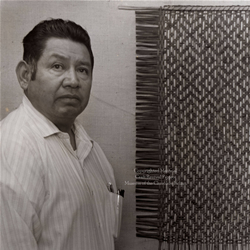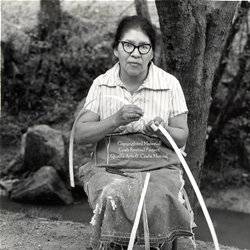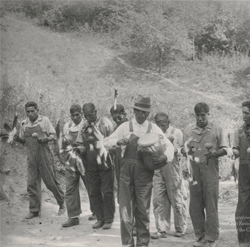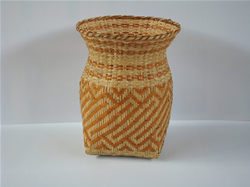Lesson Plans:
Native American Gender Roles:
Selu and Kanati in the 20th Century
Subject(s)/Grade(s): English III, 11
Related Subject(s): American History, Sociology, Art
Learning Outcomes
- Students will create a Power Point presentation
- Students will successfully use citations of images and written material
- Students will comprehend the impact of literary tradition on gender and social roles
- Students will explore the Craft Revival website for the roles of Cherokee women and men during the Craft revival, how they differed, and how the revival impacted gender roles.
Teacher Planning
- Time required for lesson: If no homework is assigned, this entire lesson should take 2-3 class periods (1.5 hr block schedule).
Materials/Resources
- Student copies of the story "Kana'ti and Selu: The Origin of Game and Corn" in Cherokee History, Myths and Sacred Formulas by James Mooney, pgs. 242-249.
- Student copies of Cherokee Women by Theda Perdue
- Internet access
- PowerPoint capabilities
- Student access to computers
Procedures
Pre-Activities
- It is sometimes fun to provide the students with a copy of “How to be a good wife” from a 1954 Home Economics High School Text Book.
- Students should be proficient in citations. This lesson provides an opportunity for practicing this skill.
Activities
- Vocabulary: Understand these terms: Origin Story, Kana'ti (The hunter), Selu (Corn), Allegory, Gender Roles.
- Quick write: On white board/chalk board, indicate two columns. One should be labeled “MEN” and one should be labeled “WOMEN.” Open up class by asking students to come to the board and list roles they think men should have and roles they think women should have in our society. Be prepared for a lively debate!
- Reading roundtable: As a class, read Mooney's example of the Kana'ti and Selu story. Discuss the following essential elements:
- What traditional roles did Kana’ti and Selu play in the home?
- What actions caused these roles to change?
- How is “sin” defined in this traditional story?
- What do the traditional roles of man (father) and woman (mother) say about Cherokee culture?
- What type of relationship did Kana’ti and Selu share? Were their roles equal, complimentary, one-sided, etc.?
- Group project: Divide the class into 8 groups. (Depending on class size, some groups may need to double-up) Assign each group a chapter from Theda Perdue's Cherokee Women. After reading its assigned chapter, each group will explore the Craft Revival website for the history of the movement and the various crafts that the Cherokee contributed. Remind students that the Craft Revival took place in the late 19th century/early 20th century (after Amer-European influence). Teacher may need to introduce the site to the students on a projector and practice using the search engine. Each group will develop a properly cited PowerPoint presentation that:
- connects Perdue reading to the Kana'ti and Selu story. (25 pts)
- discusses the impact Amer-European culture had on Cherokee gender roles. (25 pts)
- discusses the crafts of the Craft Revival and whether men or women typically mastered these crafts. (25 pts)
- has an hypothesis about why Cherokee women produced certain crafts (traditional or modern reasons) and why men selected certain crafts (traditional or modern reasons). They must support their hypothesis with evidence from the two readings. Possible answers may include: men making Booger Masks because of their traditional roles as ceremonial leaders or women learning basket-making for carrying items like vegetables from their mothers (citing Selu). Europeans introduced farming as a male gender role. Or men making baskets during the Revival as a means of being the modern bread-winner. (25 pts)
- includes photos from the Craft Revival website to support the information on Power Point. (Extra Credit)
- Wrap Up: End the lesson with a class discussion about cultural literature, work, and gender roles. You can do this as a whole-class informal discussion, roundtable, or formal writing exercise. Refer to the quick write activity #1 to help students make connections. Guiding questions:
- What do our roles as men and women say about our cultural values?
- Are certain art forms gender specific?
- What types of traditional stories influence our own conceptions of “women’s work” vs. “men’s work?”
- Do you think these stories limit change in gender roles or enable them? Why?
Assessment
- PowerPoint presentations graded by a rubric (see above for points)
- Citing sources
- Wrap up discussion: oral or written
Comments
This plan can be adapted to other subjects and grades. Teachers may need to assist students with making connections between the literature and the Craft Revival.
North Carolina Curriculum Alignment
English Language Arts (2004)
Grade 11 - English III
Sources
- Mooney, James. Cherokee History, Myths and Sacred Formulas. Cherokee, NC: Cherokee Publications, 2006.
- Perdue, Theda. Cherokee Women. Lincoln, NE: The University of Nebraska Press, 1998.
Websites
- http://craftrevival.wcu.edu/
– Submitted by Annette Saunooke Clapsaddle, Swain County High School, Bryson City, North Carolina.







